#brain structure
Explore tagged Tumblr posts
Text

I personally think of it as a disorder but your brain structure is definitely different and a “divergent” one.
This information was found on online sources. Not AI
Here’s an excerpt from an article from Health Central:
How Is The Structure Of The Brain Different?
“The neuroanatomy of autism is difficult to describe,” Culotta says. So it might be easier to talk about the architecture of the brain and how the autistic brain may differ.
So what’s different in the structure of this three-pound organ? Let’s start with a quick anatomy refresher: First of all, the brain is split into two halves or hemispheres. It is these two hemispheres that we get the idea of a left brain and a right brain. In reality, our thinking and cognitive processes bounce back and forth between the two halves.
“There's a little bit of difficulty in autism communicating between the left and right hemispheres in the brain. There's not as many strong connections between the two hemispheres,” Dr. Anderson says.
In recent years, science has found that the hemispheres of ASD brains have slightly more symmetry than those of a regular brain. This small difference in asymmetry isn’t enough to diagnosis ASD, according to a report in Nature Communications. And, exactly how the symmetry may play into autism’s traits is still be researched.
The differences in the brain don’t stop there. Another quick Biology 101 review: Within each half, there are lobes: frontal, parietal, occipital, and temporal. Inside these lobes are structures that are in charge of everything from movement to thinking. On top of the lobes, lies the cerebral cortex aka grey matter. This is where information processing happens. The folds in the brain add to the surface area of the cerebral cortex. The more surface area or grey matter there is, the more information that can be processed.
https://www.healthcentral.com/condition/autism/autism-brain-differences
Here’s another excerpt from Transmitter.org
Which brain regions are known to be structurally different between autistic and non-autistic people?
Studies that make use of a brain-scanning technique called magnetic resonance imaging (MRI) have highlighted a few brain regions that are structurally distinct in people with autism.
Children and adolescents with autism often have an enlarged hippocampus, the area of the brain responsible for forming and storing memories, several studies suggest, but it is unclear if that difference persists into adolescence and adulthood1,2.
The size of the amygdala also seems to differ between people with and without autism, although researchers from different labs have turned up conflicting results. Some find that people with autism have smaller amygdalae than people without autism, or that their amygdalae are only smaller if they also have anxiety3. Others have found that autistic children have enlarged amygdalae early in development and that the difference levels off over time2,4.
Autistic people have decreased amounts of brain tissue in parts of the cerebellum, the brain structure at the base of the skull, according to a meta-analysis of 17 imaging studies5. Scientists long thought the cerebellum mostly coordinates movements, but they now understand it plays a role in cognition and social interaction as well.
On a more global level, the cortex — the brain’s outer layer — seems to have a different pattern of thickness in people with and without autism. This difference tracks with alterations to a single type of neuron during development, a 2020 study suggests.
The last excerpt is from the National Library of Medicine. Here’s an excerpt:
The constituent parts of the neural systems associated with clinical symptoms in ASD were examined by many studies. Specific core regions have been suggested to mediate clinical phenotypes of ASD such as the frontotemporal lobe, frontoparietal cortex, amygdala, hippocampus, basal ganglia, and anterior cingulate cortex (ACC) [17]. For example, abnormalities in (1) the inferior frontal gyrus (IFG, Broca's area), superior temporal sulcus (STS), and Wernicke's area might be related to defects in social language processing and social attention [18], (2) the frontal lobe, superior temporal cortex, parietal cortex, and amygdala might mediate impairments of social behaviors [19,20] and (3) the orbitofrontal cortex (OFC) and caudate nucleus have been associated with RRBs of ASD [21]. Although deficits in these regions seem to be general in ASD, some findings proposed that abnormalities in these brain regions are not peculiar to ASD and seem to be common in other disorders such as obsessive-compulsive disorder, general anxiety disorders, and schizophrenia
#autism#brain structure#neurodiversity#it’s called neurodivergent for a reason#I view it as a disorder and not disability imo#autism research#educational
109 notes
·
View notes
Text

#pale blog#pale aesthetic#weirdcore#creepycore#creepy aesthetic#anatomical illustration#anatomical study#anatomical drawing#brain structure#brain activity#brain science#brain disorder#brain function#brain waves#brain research#neurology#psychiatry#psychology#mental health#therapy#dark academia#light academia#chaotic academia#academia aesthetic#classic academia
44 notes
·
View notes
Text
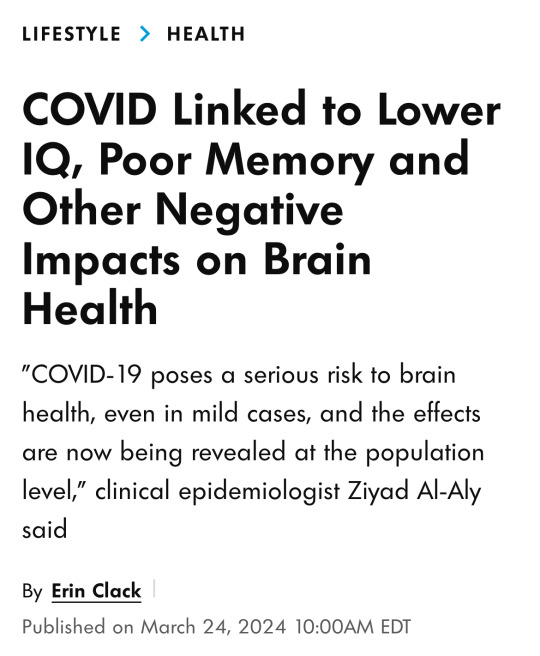

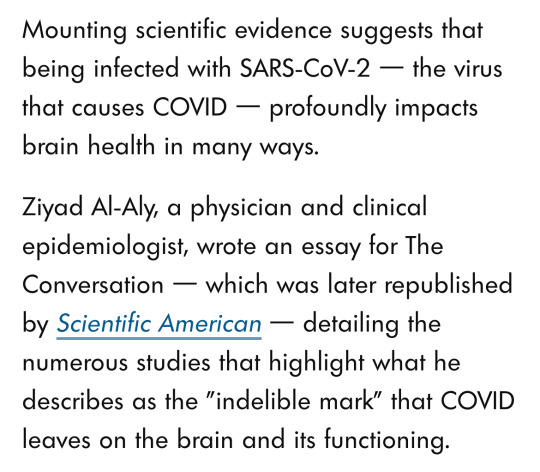
side-eyeing all the anti-vaccine, anti-masks, "get back to normal," "the kids will be fine" fucktwats hella hard right now. fuck everyone one of you.
#COVID#brain health#cognitive deficits#memory problems#brain inflammation#brain aging#brain volume#brain structure#COVID-19#SARS-CoV-2#long COVID#brain damage#dementia#autopsies#respiratory virus
94 notes
·
View notes
Text
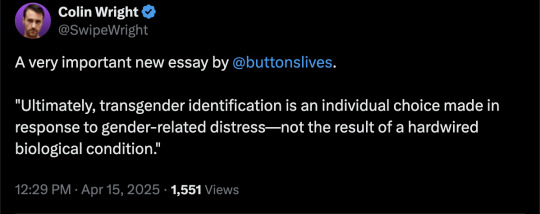
By: Christina Buttons
Published: Apr 14, 2025
The claim that transgender status is immutable and biologically based was raised in the recent case of Talbott v. Trump. Eight plaintiffs—six active-duty service members and two individuals seeking to enlist—are challenging President Trump’s January 27 executive order barring transgender individuals from military service. The plaintiffs’ filings refer to “gender identity” as a deeply ingrained and involuntary characteristic with a biological basis—language that can be used to claim constitutional protections. The plaintiffs allege that the ban amounts to unlawful discrimination under the equal protection clause of the Fifth Amendment.
During hearings in February 2025, U.S. District Judge Ana C. Reyes pressed Department of Justice attorneys on the administration’s justification for the order. She instructed both parties to brief the court on “questions of biology,” prompting the plaintiffs to submit a five-page brief arguing that transgender identity is both innate and immutable.
This claim carries implications far beyond military recruitment. Activists have used it to justify medical interventions for minors, inform education policies, and establish civil rights protections for “gender identity” comparable with those for race and sexual orientation. There’s just one problem: the plaintiffs’ brief—and the immutability argument more broadly—doesn’t withstand scientific scrutiny.
Though the plaintiffs’ filing never defines gender identity—commonly understood by its proponents as a person’s “internal sense of being male, female, both, or neither”—it nonetheless describes it as “innate,” “deep-seated,” and “impervious to change through external influences.” The brief also claims that a “scientific consensus” exists supporting the biological basis of transgender identity and asserting that transgender individuals constitute “a discernible class.”
The brief’s claim that transgender identity is both innate and immutable appears to rely on a misreading of the evidence. While “innate” typically refers to traits present at birth, “immutable” implies that they cannot be changed. Even early researchers who believed gender dysphoria might be innate did not consider it immutable—particularly in children. Decades of desistance research suggest that 85 percent to 90 percent of children with gender dysphoria who do not undergo medical transition eventually outgrow those feelings, with most going on to become gay or lesbian adults. The growing visibility of detransitioners—individuals who once identified as transgender but later reversed course—further challenges the idea that transgender identity is invariably fixed.
Even if biology plays a role, transgender identification does not arise from a single cause. The heterogeneity within trans-identified populations makes it unlikely that one universal explanation applies across the board. Research instead points to several developmental pathways: a homosexual pathway, historically seen primarily in boys and linked to childhood gender nonconformity and same-sex attraction; an autogynephilic pathway, primarily in adult men, involving sexual arousal at the thought of being female; and rapid-onset gender dysphoria, a pattern that has recently emerged mainly among adolescent girls and shaped by social and psychological factors. These distinct profiles challenge any effort to define transgender identity as a singular, biologically determined condition.
To a layperson, the plaintiffs’ brief may appear persuasive. It employs technical language, cites scientific studies, and references earlier court rulings that treated transgender status as immutable.
But none of this holds up under closer scrutiny. The rulings cited failed to examine the underlying evidence, instead reinforcing a kind of circular legal logic. The studies—focused on brain structure, twin concordance, genetics, and fetal hormone exposure—can give the illusion of a solid scientific foundation, but they are fraught with limitations. They often rely on small, non-representative samples, produce inconsistent results, fail to control for key confounding variables, and lack reliable replication. What remains is a patchwork of inconclusive findings, frequently overstated to support broad claims.
To assess the plaintiffs’ scientific claims properly, it helps to understand that, while sex itself is binary, many sex-related physical and psychological traits exist along a continuum. Some individuals naturally display traits more commonly associated with the opposite sex—often referred to as gender or sex nonconformity. Evidence suggests that prenatal hormone exposure can shape such traits in both boys and girls. Childhood gender nonconformity, a term used in clinical research, has also been strongly associated with same-sex attraction.
Social and cultural influences shape how these traits are understood and expressed. For some, these traits may cause distress, leading to a diagnosis like gender dysphoria. In today’s environment, where transgender identity is often conflated with gender nonconformity, individuals who don’t conform to traditional sex stereotypes may interpret their experiences as an internal “mismatch,” rather than as natural variations in behavior, personality, or sexual orientation.
Sex-based differences in brain structure are well-documented, and, as neuroimaging techniques advanced in the early 2000s, researchers began searching for neurological correlates of gender dysphoria. This sparked a wave of transgender brain studies, many of which received enthusiastic media coverage. Many have referenced these studies to support the idea of a “neurological sex”—that the brain possesses an internal sex separate from the body.
Building on this idea, the brief claims that “research shows transgender women and non-transgender women have similar brain structures,” citing five studies. But these findings are complicated by confounding variables. The use of cross-sex hormones—commonly used among those who medically transition—can alter brain anatomy. And sexual orientation can independently influence brain structure. When studies control for these factors, the results often show that the brains of trans-identified individuals more closely resemble those of their biological sex.
The brief also cites a review of numerous twin case studies to suggest a genetic basis for transgender identity. While identical twins in the review were more likely than fraternal twins to identify as transgender, this does not constitute strong evidence of genetic causation. The research relies on case reports of twins raised together, making it difficult to separate genetic influence from environmental and social factors. Identical twins often share closer emotional bonds, which can influence belief systems and reinforce shared identities.
In nearly every case where both twins identified as transgender, both were also homosexual. The one exception involved a pair of identical twins described in the literature as exhibiting “transvestic fetishism”—a condition now more commonly referred to as autogynephilia. This raises the possibility that the studies are not capturing a genetic basis for transgender identity, but rather a shared predisposition for same-sex attraction.
The study’s findings also diverge from what would be expected if transgender identity were strongly heritable: concordance rates between identical twins—that is, how often both twins in a pair identified as transgender—were modest, while fraternal twins showed no concordance at all. For comparison, twin studies on homosexuality show a more typical genetic pattern, with fraternal twins exhibiting about half the concordance rate of identical twins.
The brief references a study of genetic variants—differences in DNA sequences—related to sex-hormone pathways. These pathways influence how the body produces or responds to hormones like testosterone and estrogen, which may in turn affect behavior patterns traditionally associated with masculinity or femininity. Atypicality in these traits reflect gender nonconformity—not transgender identity itself. While these variants may be more common in trans-identified populations, they are neither unique to, nor predictive of, transgender identity. The authors of the study explicitly caution that “none of the studied variants could hence be assumed to be a primary cause of this condition.”
The brief also cites research on congenital adrenal hyperplasia (CAH), a disorder of sex development in which female fetuses are exposed to elevated levels of testosterone due to adrenal gland dysfunction. This excess androgen can lead to masculinized physical traits and more traditionally male-typical behaviors in childhood. While the brief interprets this as evidence that prenatal hormones shape “gender identity,” what the research actually shows is an association between prenatal androgens and masculinized behaviors or interests—that is, gender nonconformity, not identity rejection. Most girls with CAH continue to identify as female, despite these biological effects.
Taken together, the studies cited in the immutability brief do not establish that transgender identification is biologically determined. Instead, they more consistently reflect patterns of gender nonconformity and same-sex attraction. Ultimately, transgender identification is an individual choice made in response to gender-related distress—not the result of a hardwired biological condition.
Misinterpreting the findings of these studies as evidence of a fixed transgender identity risks narrowing society’s understanding of gender nonconformity. Rather than encouraging individuals to alter themselves to fit a prescribed identity, we should create space for a broader range of expression—recognizing that many gender-nonconforming children grow up to be gay or lesbian adults.
As courts and policymakers weigh the arguments in Talbott v. Trump and similar cases, they should treat claims of scientific certainty with skepticism. Decisions with profound personal and social consequences demand clear evidence, honest interpretation, and restraint in drawing conclusions that the research cannot support.
==
I love how "sex is a spectrum," yet somehow an MRI can test for and reveal a "brain sex" binary of a male brain in a female body, or vice versa. And yet also we should trust "self ID," because people can just feel the results of an MRI innately.
"Gender identity" is "innate" and "immutable," except that it's also a "social construct," "not a simple fixed binary construct," "fluid" and a "journey."
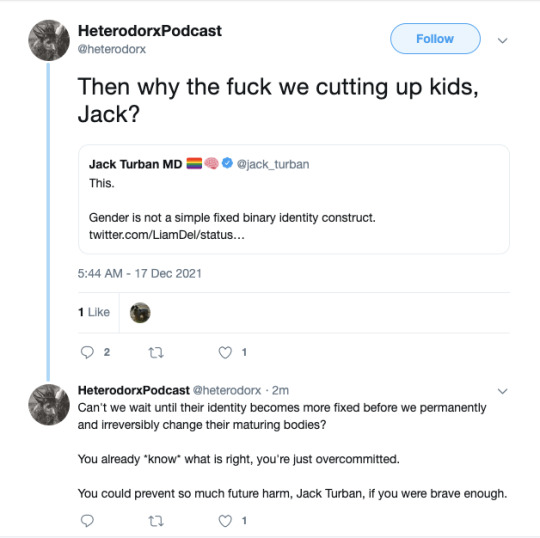
Mind-body dualism is a deranged Wonkian boatride.
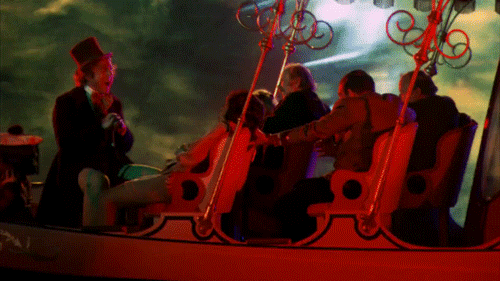
#Colin Wright#Christina Buttons#gender identity#innate#immutable#brain sex#brain structure#gender ideology#gender identity ideology#queer theory#pseudoscience#gender pseudoscience#mind body dualism#transgender identity#trans identity#detransition#detrans#religion is a mental illness
9 notes
·
View notes
Note
How do you know you're trans? Have you had a brain scan? Do you think claiming to have dysphoria is enough proof, or is transgenderism caused by something specific?
i belive transsexualism is caused by some kind of neurobiological malformation/disorder/hormonal disorder. i'm not a researcher, nor have i read the latest studies due to my personal life being chaotic af rn, but studies in the past have linked brain structure to being a potential cause for transsexualism, for which gender dysphoria is the symptom.
i have personally had an mri of my brain in the past due to a particularly bad fall and subsequent concussion a few years ago... which is also one of the reasons i've decided to get sober. but i digress.
based on the scans, my amygdala was larger than a typical female's, alongside overall brain size being roughly 10% larger than typical of females of my size. they said it likely was incendental as it's within clinical findings (just at the upper end of women/moderate area of men) and couldn't correlate it to me being trans as they were just trying to determine the extent of my injury during the fall. luckily i was brain-bleed free.
so, no, i cannot say that my brain structure is 100% the reason that i'm trans, and anecdotally, my brain structure isn't typical of cis women. whether its typical of transmen or cis men, i can't say, though my amygdala is enlarged.
i think gender dysphoria is the symptom, but again, i'm not a researcher or biologist or anything like that. i'm a vet tech who draws funny pictures. i think someone saying they have gender dysphoria is a good enough place to start
#transmed#trans discourse#transsexual#gender dysphoria#dysphoria#transmedicalism#trans#brain structure#transsexualism#sex dysphoria
5 notes
·
View notes
Text
Fucked up and wild to me how if part of the brain does not WANT to act independently for fear of punishment then the brain, WIRED TO ACT INDEPENDENTLY, will create urges and outputs and structures that let those desires come through no matter how much you resist.
Some of those structures, in extreme cases, involving "another you."
Fuck man the philosophical implications alone blow my entire mind.
5 notes
·
View notes
Text
Trauma affects brain function altering how we think, feel, relate to others, and respond. This article will shed light on how our nervous system respond to threat and how sometimes stress becomes toxic.
#brain architecture#brain development#brain response to stress#brain structure#flight and fight response#limbic brain system#neuroplasticity principles#read about trauma#sources of traumatic stress#trauma as extreme stress#trauma effects#when stress becomes toxic
0 notes
Text
youtube
0 notes
Text
Professor Emeritus Gerald Schneider, discoverer of the “two visual systems,” dies at 84
New Post has been published on https://thedigitalinsider.com/professor-emeritus-gerald-schneider-discoverer-of-the-two-visual-systems-dies-at-84/
Professor Emeritus Gerald Schneider, discoverer of the “two visual systems,” dies at 84


Gerald E. Schneider, a professor emeritus of psychology and member of the MIT community for over 60 years, passed away on Dec. 11, 2024. He was 84.
Schneider was an authority on the relationships between brain structure and behavior, concentrating on neuronal development, regeneration or altered growth after brain injury, and the behavioral consequences of altered connections in the brain.
Using the Syrian golden hamster as his test subject of choice, Schneider made numerous contributions to the advancement of neuroscience. He laid out the concept of two visual systems — one for locating objects and one for the identification of objects — in a 1969 issue of Science, a milestone in the study of brain-behavior relationships. In 1973, he described a “pruning effect” in the optic tract axons of adult hamsters who had brain lesions early in life. In 2006, his lab reported a previously undiscovered nanobiomedical technology for tissue repair and restoration in Biological Sciences. The paper showed how a designed self-assembling peptide nanofiber scaffold could create a permissive environment for axons, not only to regenerate through the site of an acute injury in the optic tract of hamsters, but also to knit the brain tissue together.
His work shaped the research and thinking of numerous colleagues and trainees. Mriganka Sur, the Newton Professor of Neuroscience and former Department of Brain and Cognitive Sciences (BCS) department head, recalls how Schneider’s paper, “Is it really better to have your brain lesion early? A revision of the ‘Kennard Principle,’” published in 1979 in the journal Neuropsychologia, influenced his work on rewiring retinal projections to the auditory thalamus, which was used to derive principles of functional plasticity in the cortex.
“Jerry was an extremely innovative thinker. His hypothesis of two visual systems — for detailed spatial processing and for movement processing — based on his analysis of visual pathways in hamsters presaged and inspired later work on form and motion pathways in the primate brain,” Sur says. “His description of conservation of axonal arbor during development laid the foundation for later ideas about homeostatic mechanisms that co-regulate neuronal plasticity.”
Institute Professor Ann Graybiel was a colleague of Schneider’s for over five decades. She recalls early in her career being asked by Schneider to help make a map of the superior colliculus.
“I took it as an honor to be asked, and I worked very hard on this, with great excitement. It was my first such mapping, to be followed by much more in the future,” Graybiel recalls. “Jerry was fascinated by animal behavior, and from early on he made many discoveries using hamsters as his main animals of choice. He found that they could play. He found that they could operate in ways that seemed very sophisticated. And, yes, he mapped out pathways in their brains.”
Schneider was raised in Wheaton, Illinois, and graduated from Wheaton College in 1962 with a degree in physics. He was recruited to MIT by Hans-Lukas Teuber, one of the founders of the Department of Psychology, which eventually became the Department of Brain and Cognitive Sciences. Walle Nauta, another founder of the department, taught Schneider neuroanatomy. The pair were deeply influential in shaping his interests in neuroscience and his research.
“He admired them both very much and was very attached to them,” his daughter, Nimisha Schneider, says. “He was an interdisciplinary scholar and he liked that aspect of neuroscience, and he was fascinated by the mysteries of the human brain.”
Shortly after completing his PhD in psychology in 1966, he was hired as an assistant professor in 1967. He was named an associate professor in 1970, received tenure in 1975, and was appointed a full professor in 1977.
After his retirement in 2017, Schneider remained involved with the Department of BCS. Professor Pawan Sinha brought Schneider to campus for what would be his last on-campus engagement, as part of the “SilverMinds Series,” an initiative in the Sinha Lab to engage with scientists now in their “silver years.”
Schneider’s research made an indelible impact on Sinha, beginning as a graduate student when he was inspired by Schneider’s work linking brain structure and function. His work on nerve regeneration, which merged fundamental science and real-world impact, served as a “North Star” that guided Sinha’s own work as he established his lab as a junior faculty member.
“Even through the sadness of his loss, I am grateful for the inspiring example he has left for us of a life that so seamlessly combined brilliance, kindness, modesty, and tenacity,” Sinha says. “He will be missed.”
Schneider’s life centered around his research and teaching, but he also had many other skills and hobbies. Early in his life, he enjoyed painting, and as he grew older he was drawn to poetry. He was also skilled in carpentry and making furniture. He built the original hamster cages for his lab himself, along with numerous pieces of home furniture and shelving. He enjoyed nature anywhere it could be found, from the bees in his backyard to hiking and visiting state and national parks.
He was a Type 1 diabetic, and at the time of his death, he was nearing the completion of a book on the effects of hypoglycemia on the brain, which his family hopes to have published in the future. He was also the author of “Brain Structure and Its Origins,” published in 2014 by MIT Press.
He is survived by his wife, Aiping; his children, Cybele, Aniket, and Nimisha; and step-daughter Anna. He was predeceased by a daughter, Brenna. He is also survived by eight grandchildren and 10 great-grandchildren. A memorial in his honor was held on Jan. 11 at Saint James Episcopal Church in Cambridge.
#2024#affiliate#Analysis#Animal Behavior#Animals#author#bees#Behavior#book#Brain#Brain and cognitive sciences#brain injury#brain structure#brains#career#Children#college#Community#Conservation#development#Discoveries#effects#Environment#Faculty#form#Foundation#Full#Fundamental#Future#growth
0 notes
Text
THE NEW CHAPTER OF MISTAKES ON MISTAKES UNTIL IS OUT AND YOU ALL KNOW WHAT THAT MEANS~~~~~~
Spoilers for ch 74 below >:)


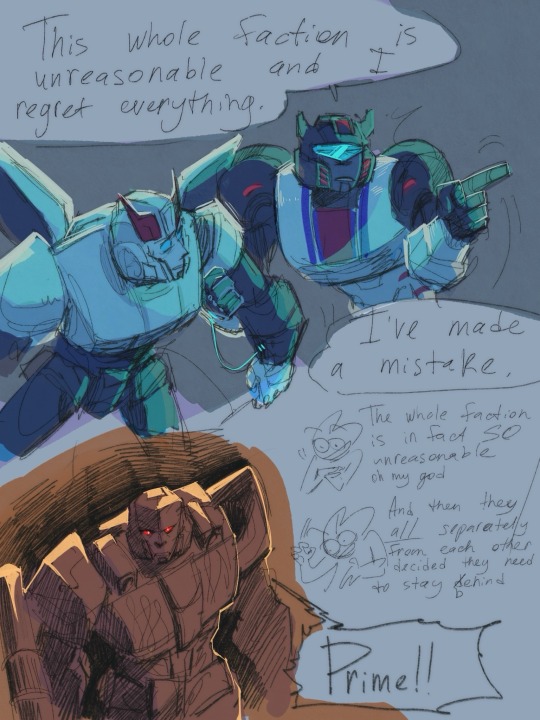

Head in hands. And then they all happened to be self sacrificial idiots.
Infinitely delighted by the fact that Optimus automatically decided to catch whoever was falling and only look who that was afterwards. 100/10. Peak Optimus writing.
#fic fanart#momu fanart#maccadam#transformers#jazz#prowl#jazzprowl#optimus prime#megatron#momu is so good it made me draw megatron again✊ this is what true power looks like#teeny tiny doodle of Ratchet#I love momu Optimus beyond imaginable#usually I’m much more interested in him while he’s still Orion#because Optimus feels much more restricted in his thoughts and actions you know#in fics. I forgot to say I was talking about OP in fics#but in MOMU? I don’t even know how to describe it?? He is so comforting#he is all responsible and noble but also JUST the right amount of whimsical and chaotic 🤌#also I WAS NOT PREPARED for that level of architectural descriptions#my brain went ‘bruh we don’t fucking know all those words for space station structure components let’s give up how about that’#ahahahahahdjdjjfjf#not a critique by the way absolutely not#I’m gonna reread this fic at least one more time to catch more details and understand more of#uh#*vaguely waves hands*#this. everything.#because I’m 100% sure the whole story is FILLED with more layers I haven’t catch purely because I didn’t know what to look for
2K notes
·
View notes
Text
hey Rain World fans. I'm gonna show you a lore interpretation that I personally have never seen anyone talk about except myself. If you know me as Sliverist, then you know what's up.
Everyone knows the first five Karma glyphs represent the so-called Five Natural Urges. Violence, reproduction, trade and social connection, eating, and self preservation. People generally believe the next Karma glyphs before the tenth are meaningless, but this is WRONG. Understanding this revelation requires seeing the big picture, which I will guide you through.
Rain World really likes to blur the line between organic and inorganic, with the most obvious example being the Iterators themselves, these biomechanical superstructures whose function in large part is outsourced to their "microbe strata" (Purple SL pearl), but it goes even further, into the very world design.
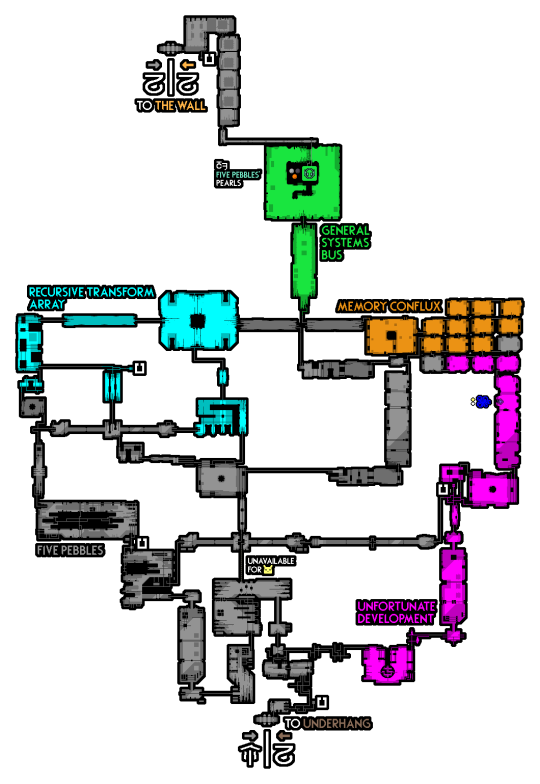

Five Pebbles' internal structure resembles a brain with its many sections all divided into specific regions with specific purposes. His chamber makes the resemblance even more obvious, where you can clearly see the brainstem.


Within Five Pebbles' dark interior swim swarms of colorful neurons which turn white in broad daylight, each one a carrier of information. Often, they are brushed along by cilia lining the computer halls.
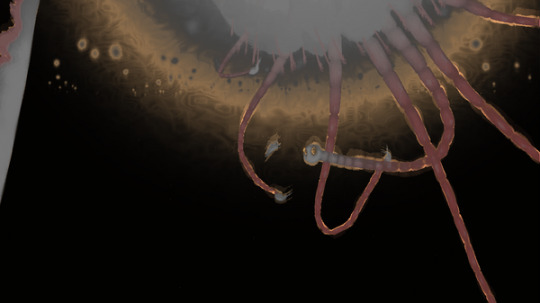

The Void Sea writhes with a swarm of beings enormous beyong reckoning which closely resemble real neurons. The void worm that takes interest in the slugcat uses a dendrite to make a tether to drag the slugcat to its final destination.

As the slugcat swims and swims, it is joined by countless many just like it, and together they swim toward the light, referred to in the code as "TheEgg" (VoidSeaScene.cs)

This is the table of Karma, showing every level above Five. Doesn't it look rather like..


dividing cells being crossed out?
In Rain World, birth and life, cognition and enlightenment, death and ascension are all inextricably connected concepts. You might even say they're connected in a cycle. The imagery and themes are rich and complete, integrated fully into the world. This is even without mentioning the voidspawn which also resemble sperm, swimming to the same place. This is why Ascension is the best ending :artiyoy:
#kvetches#rain world#rain world lore#i could even argue that an iterator chamber or even structure somewhat resembles a womb. less closely than a brain but. hehe
1K notes
·
View notes
Text
rookanis really is like... first base is you walking through the haunted ruins of my mind to find me in an act of breathtaking psychological intimacy with added tam lin undertones. second base is baked goods (cautious erotic connotations). third base is deicide. THEN we kiss. also second deicide of course once you pop it's hard to stop
#I cannot stress this enough -- ideal relationship development for me. best friends who kiss and also kill god together sometimes#no notes#dragon age#dragon age: the veilguard#dragon age: the veilguard spoilers#dragon age spoilers#rook x lucanis#rookanis#lucanis dellamorte#oc: Ellaryen Ingellvar#the way inner demons is structured reminds me a lot of the development through garak's stories in the wire in ds9#which was something that some long time readers might remember also made me feel INSANE to contemplate#in the very best of ways. I pray for my brain to get it together to the point where I can make the inner demons analysis post#that lives in my heart. I already have the video part of it put together. one day. one day please.#(the paralleling 'yours is the kindest voice in my mind' subtext especially is like. augh. AUGH.)#if I trust my thoughts to anyone it's you. you know my mind. I've assumed you know my heart because it beats for you it's been beating --#that thing mary kirby said about how both lucanis and spite trust rook above other people and themselves#heLLO hello can anyone hear me it all makes me feels so out of my mind
459 notes
·
View notes
Text

Took a break from the art fight grind to come out of helsknight obsession retirement
#atlas.art#artists on tumblr#mcyt#hermitcraft#helsknight#welsknight#you know. the painting.#feeling about him again. as always#i say retirement it was just like. 2 months where he wasn't at the forefront of my brain 24/7#call that a brief moment of peace#(I was doing worse actually. apparently helsknight obsession is a structural pillar for my mental health /hj)#anyways kind of in love with how this came out. probably gonna put it on the redbubble
238 notes
·
View notes
Text
i wont lie i always just forget what i made previously so i forget i actually have made progress. like something has occurred






(2021/2022 vs 2025)
#guy who discovered shapes#also colours apparently#also i just think anatomy/face structure. feels a little more purposeful now. still long noses but they arent as mushy#(post was sparked by seeing that old fearne drawing)#kiddo say#usually making art all thats in my brain is what im making at that moment (or planning ahead if its project work)so its fun to look back#but im a huge fan of in-the-moment just sketching#looking back there is a lot i still think is nice.but lots of things im like ah i can do that better now . my lines are better#its bc of drawing in pen a lot now i think
333 notes
·
View notes
Text
I think in media analysis and just like, engaging with art of any form, you can focus on being right all the time or you can focus on enjoying yourself, and people who do the latter often end up being pretty good at predicting things (and are often delighted by being wrong in an interesting way) and people who do the former usually end up being not just miserable, but also not very good at being right in the first place.
#i'm thinking about that how to enjoy things more essay it is actively rewiring my brain as we speak#but specifically the part about how the author tries to guess twists or develop a sense of pop music structure#but also how it's win-win: you guess right OR you are delighted by a well-executed subversion#and like. some works are just bad OR not to your taste or both but like. you'll still have more fun by not minding if you're wrong
253 notes
·
View notes
Text
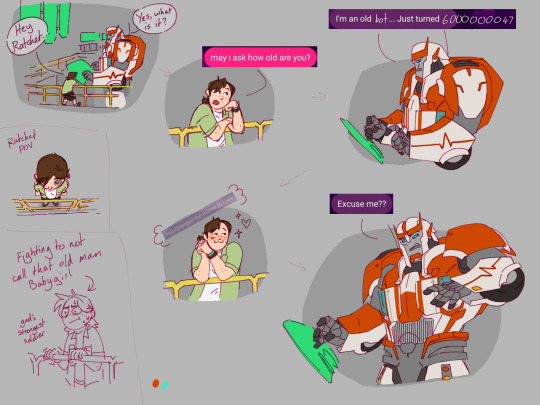
I remembered that "love theme" image while i was doodling and had an idea lol
Also have a bunch of my screenshot trace studies from trying to figure out how tf these guys work lol.

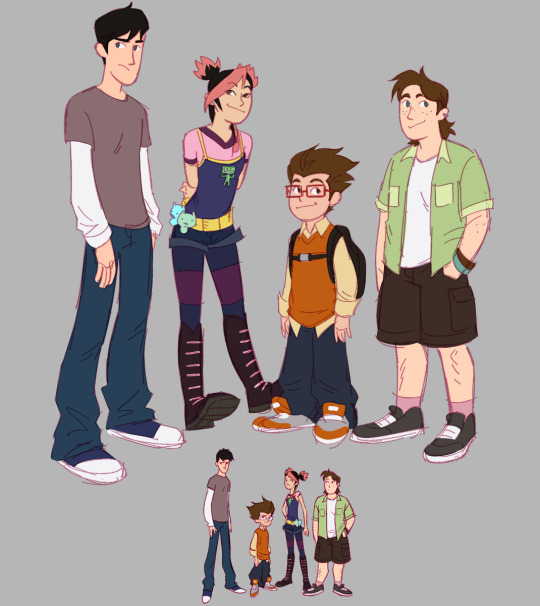
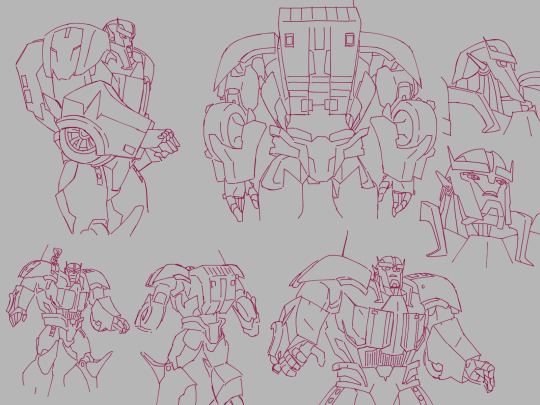


#tfp ratchet#transformers#calling all old man fans lol#fanart#self insert#does this count as self ship?? lol#probably better tag it anyway??#self ship#bonus wheeljack in there too lol#rewatching transformers prime + having fun with it#taking a lot of reference screenshots lol#every one of my fictional old men I get obsessed with is tthis guy's fault btw#just so you know#he got built into my brain structure + i was never the same lol#I can do whatever I want forever!
180 notes
·
View notes